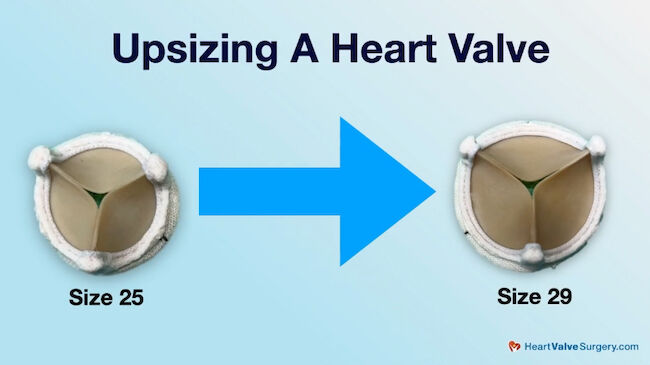Aortic Valve Replacement Size: Why Does It Matter for TAVR Reoperations?
Written By: Allison DeMajistre, BSN, RN, CCRN
Medical Expert: Nicholas Lopez, MD, Cardiac Surgeon, Baptist Health Paducah
Reviewed By: Adam Pick, Patient Advocate, Author, and Website Founder
Published: January 13, 2025
One of the most important decisions surgeons make when planning to replace the aortic valve is determining the appropriate size for the patient. The size of the valve must match the size of the person or else the patient is at risk for patient prosthesis mismatch. The size is also crucial when considering a future valve-in-valve replacement.
We recently received a patient question about aortic valve size and re-replacement from Charlie, who asked, “I had my aortic valve replaced with a 25-millimeter bovine tissue valve. If I need another heart surgery, could transcatheter aortic valve replacement, TAVR, be used to replace that valve?”
I was thrilled when Dr. Nicholas Lopez, a leading cardiac surgeon at Baptist Health Paducah in Paducah, Kentucky, agreed to weigh in on Charlie’s question while we were at the Annual Meeting of the Society for Thoracic Surgeons in San Antonio.

Dr. Nicholas Lopez (Heart Surgeon)
Key Learnings About Aortic Valve Sizing
Here are important insights shared by Dr. Nicholas Lopez during our interview:
- Correct sizing of the valve is a priority. Lopez stated, “So, sometimes knowing a little more about somebody actually helps to get a better answer. But in general, the larger the size of the valve, the better that valve is going to fit that person. When that person is getting surgery, we absolutely want to try to size that valve to that person. And we have some measurements that we can get that valve to what we think they are.”
- Upsizing will help with valve efficiency. “As surgeons, we try to upsize once, if not twice, to fit that person and give them a little more leeway for the most effective, efficient valve,” said Dr. Lopez. “If that valve is a 25, very likely a TAVR valve can be placed without much difficulty and still achieve a highly efficient valve and not have some stenosis, which is what we do not want to have.”

- “Fracturing” can help make a valve larger. Dr. Lopez said, “Another solution that can be done is to sometimes open that valve up with a balloon so we can make that valve larger. The term is called fracturing, and that can allow us to squeeze in another valve that may be too small for that individual.”
- As Dr. Lopez was explaining fracturing, we received another patient email from Valerie, who has a 21-millimeter valve. I asked if fracturing could be applied with a valve of Valerie’s size. Dr. Lopez said, “Absolutely. When you start looking at the different valves available, a 19-millimeter tends to be the smallest tissue valve, a 21-millimeter is the next size up. That valve may be perfectly appropriate for her. The problem is as you start getting toward the smaller size valves, sometimes it may not be the most effective valve with another placed within it because, at the end of the day, it will be slightly smaller inside every time. So that’s where you can go ahead and take a balloon and literally crack open the actual rim of that valve. Then that gives us new space to go ahead and put in a valve that is appropriate for her.”
Thanks Dr. Lopez and Baptist Health Paducah!
On behalf of the patients at HeartValveSurgery.com and patients across the world, thank you, Dr. Lopez, for sharing your expert insight into aortic valve sizing for TAVR re-replacement procedures. We also want to thank your team at Baptist Health Paducah in Paducah, Kentucky, for taking great care of heart valve patients!
Related Links:
- Surgeon Q&A With Dr. Lopez: Is It Safe To Be Home Alone After TAVR?
- Bioprosthetic Valve Fracturing and Remodeling During Valve-in-Valve TAVR
Keep on tickin!
Adam
P.S. For the deaf and hard-of-hearing members of our community, I have provided a written transcript below.
Video Transcript:
Adam Pick: Hi everybody. It’s Adam with heart valve surgery. com and we’re in San Antonio at the annual meeting of the society for thoracic surgeons. I am thrilled to be joined by Dr. Nicholas Lopez, who is a leading cardiac surgeon at Baptist Health Paducah in Paducah, Kentucky. Dr. Lopez, it is great to see you and thanks for being with me today.
Dr. Nicholas Lopez: Thank you for having me today.
Adam Pick: Yeah, so we have all these great things happening here at STS. We’re also getting a lot of patient questions from our community. This one came in from Charlie and he asks, I had my aortic valve replaced with a 25 millimeter bovine tissue valve. If I need another heart surgery, could transcatheter aortic valve replacement, TAVR, be used to replace that valve?
Dr. Nicholas Lopez: That’s a great question. So sometimes knowing a little more about somebody actually helps to get a better answer. But in general, the larger the size of the valve, the better that valve is going to fit that person. When that person is getting surgery, we absolutely want to try to size that valve to that person. And we have some measurements that we can get that valve to what we think they are. And of course, as surgeons, we try to upsize once, if not twice, to fit that person. person and give them a little more leeway and give them the most effective efficient valve. If that valve is a 25, very likely a TAVR valve can be placed without much difficulty and still achieve a highly efficient valve and not have some stenosis, which is what we do not want to have. Another solution that can be done is to sometimes, uh, open that valve up with a balloon so we can make that valve larger. The term is called fracking, and that can allow us to squeeze in another valve that may be, may be too small for that individual.
Adam Pick: Well, Dr. Lopez, I was not familiar with fracturing a valve. Take it one step further. We just got another email, literally five minutes ago, from Valerie, who has a 21 millimeter valve. Is that still something, fracturing, that could be applied?
Dr. Nicholas Lopez: Absolutely. When you start looking at the different valves available, a 19mm tends to be the smallest tissue valve, a 21mm is the next size up. That valve may be perfectly appropriate for her. The problem is as you start getting toward the smaller size available valves. Sometimes that valve may not be the most effective valve with another valve placed within it because at the end of the day, it’ll be slightly smaller inside every time. So that’s where you can go ahead and take a balloon and literally crack open the actual rim of that valve. And then that gives us new space to go ahead and put a valve that’s appropriate for her.
Adam Pick: Wow, what an innovation. And Charlie, I hope that helped you. I know it helped me. And Dr. Lopez, on behalf of the patients at HeartValveSurgery. com. Patients all over the world. Thanks to you and your team at Baptist Health Paducah in Paducah, Kentucky. Thanks for being with me today. Thank you very much.
Dr. Nicholas Lopez: Appreciate it.





